Gunumeleng — The Build Up — What to Expect

Unless you have spent a substantial amount of time in the tropics, it is unlikely that you have ever experienced anything like our Build Up. While it does resemble the weather you sometimes get in temperate climates, it is different. Television weather reports lie. They do not do so intentionally, but the symbols they use were all designed for other climates. Looking at the TV weather reports, many people get the impression that it rains all day, every day. It would be closer to the truth to say that it doesn't rain at all.
The photo at left was taken on one of our Build Up walks in Kakadu in late October. We could see the storm building. Later that night, we could see lightning in the distance. We did not get a single drop of rain. While it is likely to rain somewhere nearly every day in the later part of the build Up, the rain comes as short, sharp, isolated storms. A given location is likely to get rain on only a few days. On average, the weather station in Jabiru in northern Kakadu gets rain only 3 days in October and 12 in November. Further south, it is drier.
You may feel that there are far too many photos on this page but we believe it is important to give people as good a picture as possible so that those who do come will come prepared for the conditions that they encounter and leave with wonderful memories that will last a lifetime — or at least until their next Build Up trip.
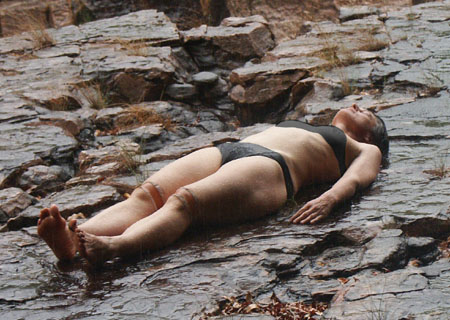
If you do a multi-day walk in the Build Up, you are going to hope that you get rained on. Hope you get rained on? Getting rained on in the tropics is a far different experience to getting rained on in a cooler climate. Look at the woman in the photo at right. It was taken the day after the photo above. It is raining. She is happily napping in the rain. Can you imagine doing that in a cooler climate? Tropical rain is different. Walking in the rain can be enjoyable; a raincoat can become an unnecessary weight. 'Breathable" fabrics don't breathe when it's warm so you'll get wet anyway. At this time of year, it's not going to last. Why not relax and enjoy it?
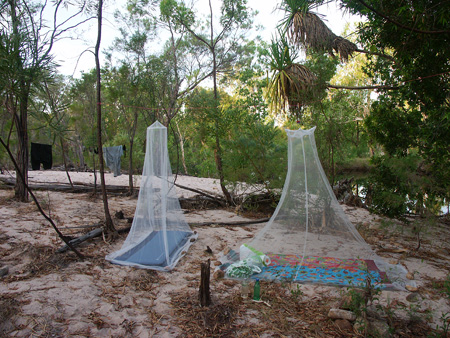
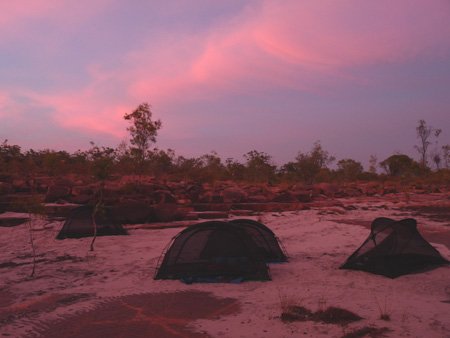
It is going to be hot and it is going to be humid. The average daily maximum temperature is about 38°C (100°F). Nighttime minimums are normally 24-25°C (75-77°F). That's why we spend so much time enjoying the cool gorges and do our best to avoid walking in the heat of the afternoon. That's why ordinary tents are not a good choice.
Hanging mosquito nets as shown in the photo at far left are the lightest possible answer. Where else can you happily carry a shelter weighing less than 500 g. That 500 g includes a light plastic sheet you can pull over yourself if you do get rain at night. The photo also shows just how close we camp to the pools. This makes it very easy to cool off any time you wish.
The photo at near left shows a group of mossie domes. These are free standing, fully enclosed tents with walls made entirely of mesh. Depending on the quality of what you get, they can weigh from 1.5 to 2.5 kg with a fly. As you can see in the photo, no one was using a fly as rain looked very unlikely. We do, however, recomment that you carry a fly to cover the dome if it rains — or at least a light plastic sheet as with the hanging nets.

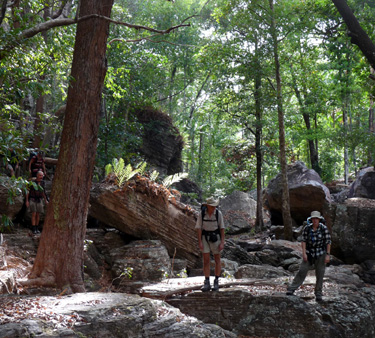
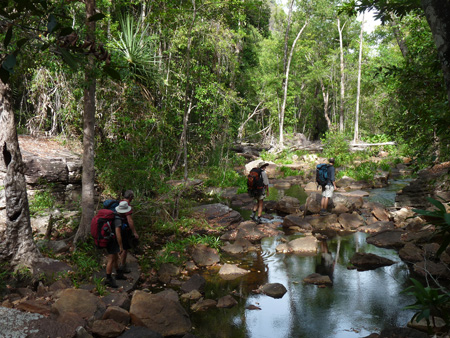
Shady gorges. Wherever possible, we spend lots of time exploring shady gorges like the ones shown at right. The first two photos are in Anbadgoran or the rainforest gorge near Jim Jim. The far right shows a group on a day walk up one of the gorges in the Graveside (Bilkbilkmi) area. Walks up and back through these gorges require wading or swimming — always welcome.
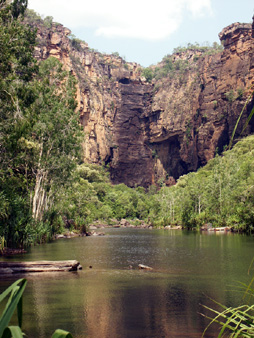
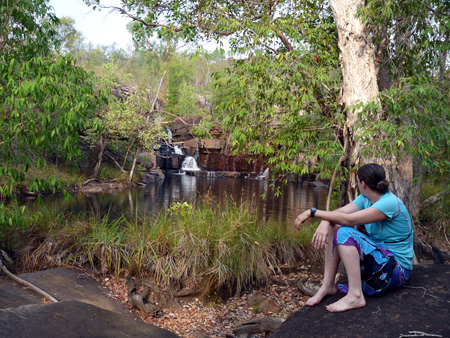
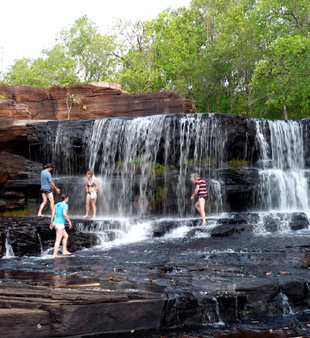
Flowing water. At this time of year, many of the creeks in Kakadu are reduced to a series of isolated water holes with no visible flow between them. There are, however, some notable exceptions and these are where we spend most of our time. The photo at far left shows a dry Jim Jim Falls in November. This is all that day trippers will see. The other two photos were taken a few days later and show the top two waterfalls at Anbadgoran, a wonderful, rainforest-filled gorge fed by permanent springs.
The hard part. While we spend as much time as possible enjoying the pools and shady places, these are walking trips. We have to get from one pool to the next. Sometimes we have no choice but to walk in the middle of the day. The four photosw below show you what it is like. From let to right: walking through the woodland as we move between creeks in the Graveside (Bilkbilkmi) area; at the top of Motorcar Falls (we'd just climbed up from the plains below); walking along uper Motorcar Creek; walking along the central part of Cascades Creek. While the last two photos show beautiful pools, there is no shady place to stop near either of them.

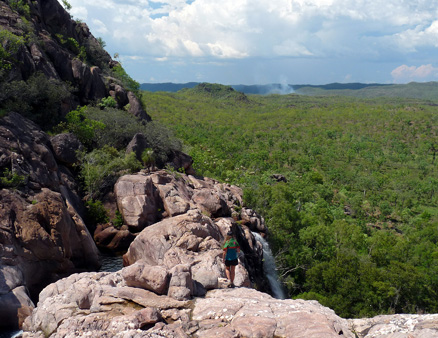


The reward — swims, swims and more swims. Sometimes, you can even swim to dinner.
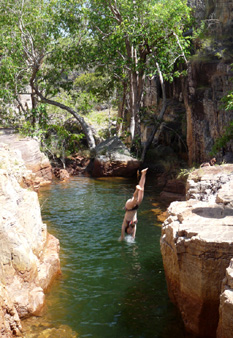
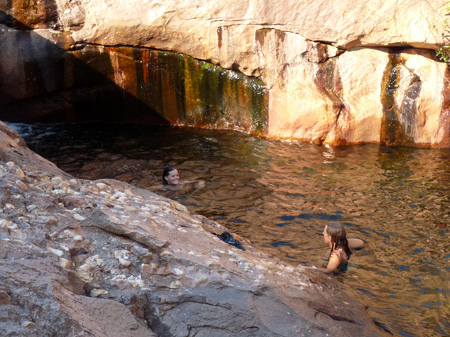

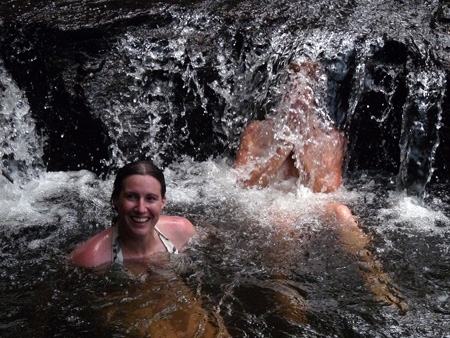
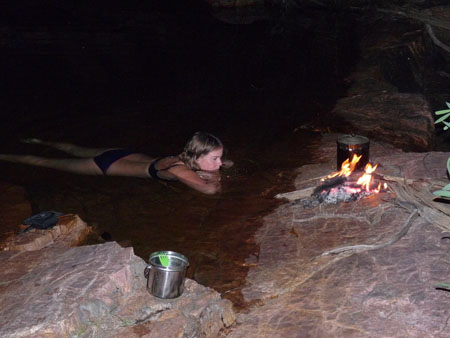
It's not just the big picture. The little things are a big part of what makes this a very special time of year.
Flowers are in bloom for the entire year, but new blooms appear everywhere with the first rains. Insects and small animals can be a delight.

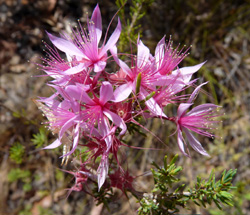



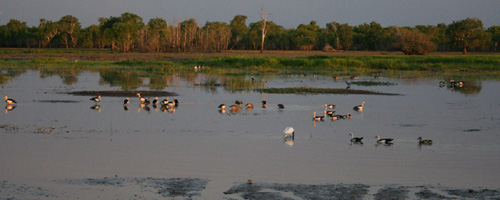
Birds. This is the time of year when birds concentrate around the remaining water holes in incredible numbers.
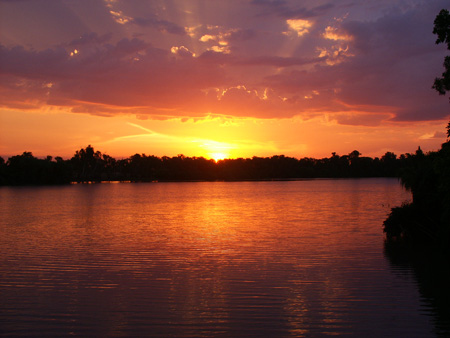
Want to come? You're almost there!
- From mid September through mid December, every trip in Kakadu and the Top End is a Build Up trip.
- Everyone who does any of our trips, wet season or dry, needs to read out Bushwalking Guide. Read it now or later, but you must read it before you come on a trip.
- Our General Information sheet has details about how we rate the level of difficulty of our trips, our discounts and cancellations fees.
Have any questions? Please send an email to walkabout@bushwalkingholidays.com.au
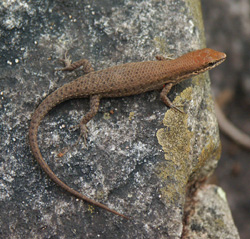
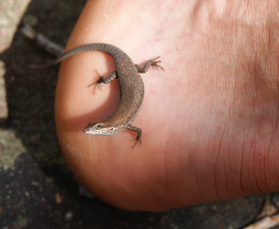

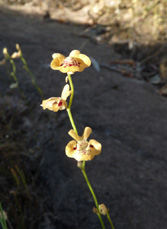
 share
share